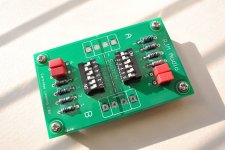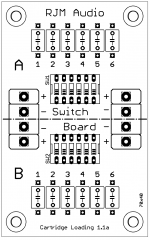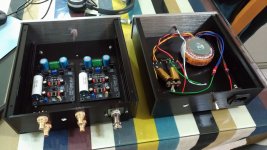It's time to play that game again. I was sent an older Phonoclone 3 recently to check out, so I had a chance to compare it against the fully kitted out Emerald 1.0s pictured above.
The Emerald hasn't had a chance to break yet, but since all the small details are masked by the digital recording anyway it doesn't really matter. These are recorded through the Sapphire preamp at 3 dB gain, mainly for convenience .... it doesn't change the sound any.
AL Stewart - On the Border - Emerald 1.0s
Al Stewart - On the Border - Phonoclone 3.5h
I was pleasantly surprised by the PC3. I'd kinda written off the X-Reg but in isolation it sounds fine - clear and clean, with excellent resolution. Just, relative to the S-Reg boards, a little bit harsh and with a somewhat confused soundstage.
I think that comes through in the wav files. A lot of the additional goodness of the Emerald is unfortunately lost. As for the difference between the 1.0s and 1.0c (i.e. changing to the MUSE KZ caps, primarily) the initial impression was of more "weight" but it's hard to say with certainty.
The Emerald hasn't had a chance to break yet, but since all the small details are masked by the digital recording anyway it doesn't really matter. These are recorded through the Sapphire preamp at 3 dB gain, mainly for convenience .... it doesn't change the sound any.
AL Stewart - On the Border - Emerald 1.0s
Al Stewart - On the Border - Phonoclone 3.5h
I was pleasantly surprised by the PC3. I'd kinda written off the X-Reg but in isolation it sounds fine - clear and clean, with excellent resolution. Just, relative to the S-Reg boards, a little bit harsh and with a somewhat confused soundstage.
I think that comes through in the wav files. A lot of the additional goodness of the Emerald is unfortunately lost. As for the difference between the 1.0s and 1.0c (i.e. changing to the MUSE KZ caps, primarily) the initial impression was of more "weight" but it's hard to say with certainty.
Photo of completed SwitchBoard 1.0d, 1k, 221R,100R,22R1 and 100pF x2 as per the BOM.
I'm thinking it might be more intuitive to rotate the "B" channel parts so that both DIP switched point "up" and the parts are numbered 1-6 and 1-6 rather than 1-6 and 6-1. Opinions? It's all one and the same from the electrical layout point of view.
I'm thinking it might be more intuitive to rotate the "B" channel parts so that both DIP switched point "up" and the parts are numbered 1-6 and 1-6 rather than 1-6 and 6-1. Opinions? It's all one and the same from the electrical layout point of view.
Attachments
Hmm... I would rather rotate the print on channel B, then it would be perfect mirror symmetry.... But that's just me... 🙂
Last edited:
It's not actually possible to do that in Eagle. Text labels cannot be rotated to display "upside down".
The best I can do is as shown, which personally feels more "wrong" to me than the current layout.
The best I can do is as shown, which personally feels more "wrong" to me than the current layout.
Attachments
Last edited:
Ah, well there it is then...
In that case I still think the simmetry in the layout is kind of neat, visually speaking. But yes, for some it might be more intuitive to rotate the B parts... But i honestly think one would get used to it as it is!
In that case I still think the simmetry in the layout is kind of neat, visually speaking. But yes, for some it might be more intuitive to rotate the B parts... But i honestly think one would get used to it as it is!
My 2 cents...
Right now the switches on both channels go in or out to turn on or off. It is my "opinion" that having each channels switches move different directions for the same purpose would be bad. Flipping the switch dip and components to keep the same numbering scheme and symmetry would look nice but you would have to source additional components (switch).
Right now the switches on both channels go in or out to turn on or off. It is my "opinion" that having each channels switches move different directions for the same purpose would be bad. Flipping the switch dip and components to keep the same numbering scheme and symmetry would look nice but you would have to source additional components (switch).
Meaning you prefer the 1.1a iteration above where the switch direction is the same, as opposed 1.0d where it's mirrored across the board centerline?
Meaning you prefer the 1.1a iteration above where the switch direction is the same, as opposed 1.0d where it's mirrored across the board centerline?
In 1.1a do the switches move in the same direction to be "on" or opposite directions?
To me the only issue with the current board is the numbering... If they didn't have numbering then the caps could be moved and the two sides would be mirrored AND the switches would both be moved inward for the same function.
Do they make an un-numbered switch?
Pretty sure they all come with the switches numbered. It would be weird if they didn't, if you think about.
Unfortunately, and since they don't make separate left/right mirror image DIP switches, that means we can't implement it as you describe.
Unfortunately, and since they don't make separate left/right mirror image DIP switches, that means we can't implement it as you describe.
Pretty sure they all come with the switches numbered. It would be weird if they didn't, if you think about.
Unfortunately, and since they don't make separate left/right mirror image DIP switches, that means we can't implement it as you describe.
How about leaving the layout 'as is' but inverting the lower switch block so that everything is numbered left to right?
That way #1 is on the LHS for both channels.
Isn't that what this is?
It's a little hard to tell since the Eagle silkscreen doesn't number the DIP switch, but the ON points up on both switch units and everything would be consistent 1-6 left to right.
Everything is rotated, not mirrored.
If everything was numbered 1-6 left to right with the switch block inverted then its as near as a mirrored layout.
Attachments
post 3889 though, the 1.1a board, does exactly that, except the switch block is not inverted. If I inverted it the numbers printed on the DIP switch wouldn't match the numbers on the silkscreen.
post 3889 though, the 1.1a board, does exactly that, except the switch block is not inverted. If I inverted it the numbers printed on the DIP switch wouldn't match the numbers on the silkscreen.
A is numbered 1-6 (as now)
B is numbered 1-6 (opposite of now)
then the switch number lines up with the silkscreen
Once these green prototypes run out, I'll get black ones made. It will take a while to get through the current stash though.
You don't the caps in the power supply, and it may sound better without them.
Ok, I will try and compare the sound difference.
BTW, I visited Arashiyama and Kiyomizu Temple with family last summer.
That's my second time to Kyoto.
- Home
- Source & Line
- Analogue Source
- The Phonoclone and VSPS PCB Help Desk




